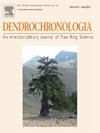Effects of historical industrial air pollution on European beech trees in Transylvania, Romania
IF 2.3
3区 农林科学
Q1 FORESTRY
引用次数: 0
Abstract
Air pollution significantly endangers forest ecosystems, particularly in cities. As urbanization and industrial activities continue to expand, air quality has decline because of the release of various pollutants from sources like burning fossil fuels, non-ferrous metal processing, mining activities, and increasing road traffic. Our study sites were located in the Copșa Mică area, which was once one of the most heavily industrialized and polluted cities in Europe. We employed a dendrochronological approach to evaluate the effects of pollution on trees, as tree rings can preserve long-term records of environmental changes, including both climate variability and pollution. This information is reflected in the width and chemical composition of the tree rings. This study aims to assess and quantify the negative spatial and temporal effects of local industrial pollution on European beech (Fagus sylvatica L.) trees. The study quantifies the effects of pollution by measuring radial growth losses in trees affected. Additionally, it examines how local industrial pollution influences the relationship between climatic factors and tree growth, depending on the extent of pollution damage. The period between 1955 and 1990, during which European beech trees were exposed to high levels of air pollution, coincides with the operation of polluting industrial units in the region. During this time, trees in the intensively polluted area experienced growth losses of 31.7 % compared to those in unpolluted area, measured by both tree ring width and basal area increment. Radial growth rates around 1990 reveal that trees in the intensively polluted area had a significant increase in growth compared to trees located in moderate and unpolluted areas. This radial growth spurt is attributed to the substantial reduction in pollution levels after 1990. Additionally, the negative effects of air pollution on the dendroclimatic response of trees were evident. In the period 1955–2000 trees in the intensively polluted area exhibited a distinct dendroclimatic response compared to those located in unpolluted areas. In particular, trees in the polluted area showed a negative response to variations in both precipitation and monthly temperature.
历史工业空气污染对罗马尼亚特兰西瓦尼亚欧洲山毛榉树的影响
空气污染严重危害森林生态系统,特别是在城市。随着城市化和工业活动的不断扩大,由于燃烧化石燃料、有色金属加工、采矿活动和道路交通增加等各种污染物的释放,空气质量有所下降。我们的研究地点位于Copșa micei地区,该地区曾经是欧洲工业化和污染最严重的城市之一。我们采用树木年代学方法来评估污染对树木的影响,因为树木年轮可以保存环境变化的长期记录,包括气候变率和污染。这些信息反映在树木年轮的宽度和化学成分上。本研究旨在评估和量化当地工业污染对欧洲山毛榉(Fagus sylvatica L.)树木的负时空影响。该研究通过测量受影响树木的径向生长损失来量化污染的影响。此外,它还考察了当地工业污染如何影响气候因素与树木生长之间的关系,这取决于污染损害的程度。在1955年至1990年期间,欧洲的山毛榉树暴露在高度的空气污染中,与此同时该区域的污染工业单位也在运作。在此期间,以树木年轮宽度和基面积增量衡量,污染严重地区的树木比未污染地区的树木损失了31.7% %。1990年左右的径向生长率表明,重度污染地区的树木比中度和未污染地区的树木生长显著增加。这种径向增长突增归因于1990年以后污染水平的大幅减少。此外,空气污染对树木的树木气候响应有明显的负面影响。在1955-2000年期间,与未污染地区相比,污染严重地区的树木表现出明显的树木气候响应。特别是污染地区的树木对降水和月温的变化均表现出负响应。
本文章由计算机程序翻译,如有差异,请以英文原文为准。
求助全文
约1分钟内获得全文
求助全文
来源期刊

Dendrochronologia
FORESTRY-GEOGRAPHY, PHYSICAL
CiteScore
5.50
自引率
13.30%
发文量
82
审稿时长
22.8 weeks
期刊介绍:
Dendrochronologia is a peer-reviewed international scholarly journal that presents high-quality research related to growth rings of woody plants, i.e., trees and shrubs, and the application of tree-ring studies.
The areas covered by the journal include, but are not limited to:
Archaeology
Botany
Climatology
Ecology
Forestry
Geology
Hydrology
Original research articles, reviews, communications, technical notes and personal notes are considered for publication.
 求助内容:
求助内容: 应助结果提醒方式:
应助结果提醒方式:


